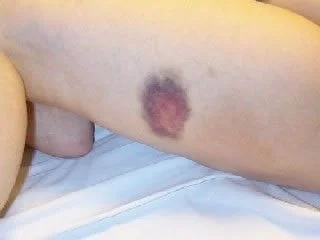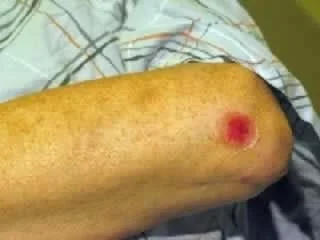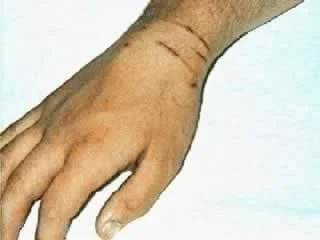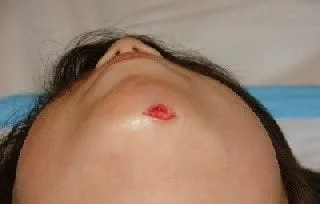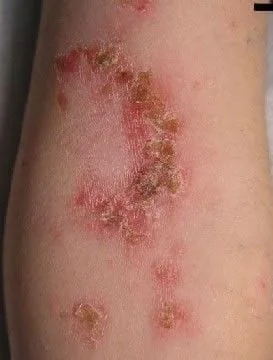Is this your child's symptom?
- Injuries to the skin anywhere on the body surface
- Includes cuts, scratches, scrapes, bruises and swelling
If NOT, try one of these:
Types of Skin Injury
- Cuts, lacerations, gashes and tears. These are wounds that go through the skin to the fat tissue. Caused by a sharp object.
- Scrapes, abrasions, scratches and floor burns. These are surface wounds that don't go all the way through the skin. Scrapes are common on the knees, elbows and palms.
- Bruises. These are bleeding into the skin from damaged blood vessels. Caused by a blunt object. They can occur without a cut or scrape.
When Sutures (Stitches) are Needed for Cuts
- Any cut that is split open or gaping needs sutures.
- Cuts longer than ½ inch (12 mm) usually need sutures.
- On the face, cuts longer than ¼ inch (6 mm) usually need to be seen. They usually need closure with sutures or skin glue.
- Any open wound that may need sutures should be seen as soon as possible. Ideally, they should be checked and closed within 6 hours. Reason: to prevent wound infections. There is no cutoff, however, for treating open wounds.
Cuts Versus Scratches: Helping You Decide
- The skin is about 1/8 inch (3 mm) thick.
- A cut (laceration) goes through it.
- A scratch or scrape (wide scratch) doesn't go through the skin.
- Cuts that gape open at rest or with movement need stitches to prevent scarring.
- Scrapes and scratches never need stitches, no matter how long they are.
- So this distinction is important.
When to Call for Cut, Scrape, or Bruise
| Call 911 Now
Call Doctor or Seek Care Now
| Contact Doctor Within 24 Hours
Contact Doctor During Office Hours
| Self Care at Home
|
Care Advice for Minor Cuts, Scrapes or Bruises
- Cuts, Scratches and Scrapes - Treatment:
- Use direct pressure to stop any bleeding. Do this for 10 minutes or until the bleeding stops.
- Wash the wound with soap and water for 5 minutes. Try to rinse the cut under running water.
- Caution: Never soak a wound that might need sutures. Reason: It may become more swollen and harder to close.
- Gently scrub out any dirt with a washcloth.
- Use an antibiotic ointment (such as Polysporin). No prescription is needed. Then, cover it with a bandage (such as Band-Aid). Change daily.
- Liquid Skin Bandage for Minor Cuts and Scrapes:
- Liquid skin bandage seals wounds with a plastic coating. It lasts up to 1 week.
- Liquid skin bandage has several benefits compared to other bandages (such as Band-Aid). Liquid bandage only needs to be put on once. It seals the wound and may promote faster healing and lower infection rates. Also, it's water-proof.
- Wash and dry the wound first. Then, put on the liquid. It comes with a brush or swab. It dries in less than a minute.
- You can get this product at a drugstore near you. There are many brands of liquid bandage. No prescription is needed.
- Bruises - Treatment:
- Use a cold pack or ice bag wrapped in a wet cloth. Put it on the bruise once for 20 minutes. This will help to stop the bleeding.
- After 48 hours, use a warm wet wash cloth. Do this for 10 minutes 3 times per day. This helps to reabsorb the blood.
- Pain Medicine:
- To help with the pain, give an acetaminophen product (such as Tylenol).
- Another choice is an ibuprofen product (such as Advil).
- Use as needed.
- Tetanus Shot:
- A tetanus shot update may be needed for cuts and other open wounds.
- Check your vaccine records to see when your child got the last one.
- For Dirty Cuts and Scrapes. If last tetanus shot was given over 5 years ago, need a booster.
- For Clean Cuts. If last tetanus shot was given over 10 years ago, need a booster.
- See your child's doctor for a booster during regular office hours. It's safe to give it within 3 days or less.
- What to Expect:
- Small cuts and scrapes heal up in less than a week.
- Call Your Doctor If:
- Bleeding does not stop after using direct pressure to the cut
- Starts to look infected (pus, redness)
- Doesn't heal by 10 days
- You think your child needs to be seen
- Your child becomes worse
And remember, contact your doctor if your child develops any of the 'Call Your Doctor' symptoms.
Disclaimer: this health information is for educational purposes only. You, the reader, assume full responsibility for how you choose to use it.
Copyright 2000-2020 Schmitt Pediatric Guidelines LLC.
Bruise on Thigh (1 Day Old)
This bruise is one day old.
Bruising occurs when the blood vessels burst and cause blood to collect in the tissue.
Abrasion on Elbow
This picture shows a shallow scrape on the left elbow.
First Aid Care Advice for Minor Scrape:
- Apply direct pressure for 10 minutes to stop any bleeding.
- Wash the area with soap and water.
- Gently scrub out any dirt with a washcloth.
- Apply an antibiotic ointment, covered by an adhesive bandage or dressing. Change daily.
- Another option is to use a Liquid Skin Bandage that only needs to be applied once. Avoid ointments with this.
Scratches from a Cat
The photo shows 3-4 parallel scratches on the wrist caused by a cat.
First Aid Care Advice:
- Wash the scratches with soap and water.
- Apply an antibiotic ointment twice daily.
- Watch closely for signs of infection, especially the first 1-3 days. Signs of infection include fever, redness or tenderness or pus at the scratch site.
Abrasion on Elbow (3 Days Old)
This scrape (abrasion) near the elbow occurred 3 days ago. The picture shows a scrape that is starting to crust over.
There are no signs of infection (such as spreading redness, pus).
Laceration - Chin
This photo shows a gaping laceration (cut) of the chin. It will require closure with either sutures or skin glue (such as Dermabond).
First Aid Care Advice:
- Apply direct pressure for 10 minutes to stop any bleeding.
- Wash the cut with soap and water.
- Once the bleeding has stopped, cover with a gauze dressing or adhesive bandage.
Impetigo of Elbow
This shows impetigo on the elbow. Impetigo is a skin infection caused by bacteria. The infection causes a red sore which leaks fluid. This area will then dry and become crusty as it heals.

